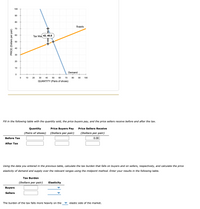
ENGR.ECONOMIC ANALYSIS
14th Edition
ISBN: 9780190931919
Author: NEWNAN
Publisher: Oxford University Press
expand_more
expand_more
format_list_bulleted
Question
question attached!

Transcribed Image Text:**Graph Analysis**
The graph illustrates the supply and demand curves for shoes, with price (in dollars per pair) on the vertical axis and quantity (in pairs of shoes) on the horizontal axis.
- **Supply Curve**: Upward sloping, showing a positive relationship between price and quantity supplied.
- **Demand Curve**: Downward sloping, indicating an inverse relationship between price and quantity demanded.
The intersection of the supply and demand curves indicates the equilibrium point, labeled with the coordinates (42, 46.8), representing an equilibrium price of $46.8 per pair and a quantity of 42 pairs sold.
A tax wedge is shown as a gap between the supply and demand curves at the new equilibriums, highlighting the impact of a tax.
**Table to Fill Out**
1. **Fill in the following table with the quantity sold, the price buyers pay, and the price sellers receive before and after the tax.**
| Quantity (Pairs of shoes) | Price Buyers Pay (Dollars per pair) | Price Sellers Receive (Dollars per pair) |
|-----------------------------|--------------------------------------|-------------------------------------------|
| Before Tax | | 0.00 |
| After Tax | | |
2. **Using the data you entered in the previous table, calculate the tax burden that falls on buyers and sellers, respectively, and calculate the price elasticity of demand and supply over the relevant ranges using the midpoint method. Enter your results in the following table.**
| Tax Burden (Dollars per pair) | Elasticity |
|-------------------------------|------------|
| Buyers | |
| Sellers | |
**Conclusion**
- The burden of the tax falls more heavily on the ______ elastic side of the market.
Expert Solution
This question has been solved!
Explore an expertly crafted, step-by-step solution for a thorough understanding of key concepts.
This is a popular solution
Trending nowThis is a popular solution!
Step by stepSolved in 3 steps

Knowledge Booster
Similar questions
- Judging types O Miss deadlines Take a long time to make decisions Are judgmental people Come through with their decisions at the last minute O Are all about their schedule and making decision upfrontarrow_forwardFor distract drivingarrow_forwardplease answer second question as a different question now!arrow_forward
- which technology change affect consumer tastearrow_forwardPlease pass question on to someone with more knowledge. I do not like using up my questions for wrong answers.arrow_forwardImagine you are the mayor of a town and you are trying to decide if you should pay for a fireworks show. Your staff survey your 400 citizens who say that they each value a fireworks show at $10. The fireworks show only costs $3,000 so you put on the show but when you ask for donations to pay for the fireworks you only receive $25 total. What does this result show? Select an answer and submit. For keyboard navigation, use the up/down arrow keys to select an answer. You staff's survey must have overestimated the value of a fireworks show. b The fireworks cost must have been greater than their economic benefit. The firework show suffered from the Tragedy of the Commons problems d The town's citizens were free-riders.arrow_forward
arrow_back_ios
arrow_forward_ios
Recommended textbooks for you

 Principles of Economics (12th Edition)EconomicsISBN:9780134078779Author:Karl E. Case, Ray C. Fair, Sharon E. OsterPublisher:PEARSON
Principles of Economics (12th Edition)EconomicsISBN:9780134078779Author:Karl E. Case, Ray C. Fair, Sharon E. OsterPublisher:PEARSON Engineering Economy (17th Edition)EconomicsISBN:9780134870069Author:William G. Sullivan, Elin M. Wicks, C. Patrick KoellingPublisher:PEARSON
Engineering Economy (17th Edition)EconomicsISBN:9780134870069Author:William G. Sullivan, Elin M. Wicks, C. Patrick KoellingPublisher:PEARSON Principles of Economics (MindTap Course List)EconomicsISBN:9781305585126Author:N. Gregory MankiwPublisher:Cengage Learning
Principles of Economics (MindTap Course List)EconomicsISBN:9781305585126Author:N. Gregory MankiwPublisher:Cengage Learning Managerial Economics: A Problem Solving ApproachEconomicsISBN:9781337106665Author:Luke M. Froeb, Brian T. McCann, Michael R. Ward, Mike ShorPublisher:Cengage Learning
Managerial Economics: A Problem Solving ApproachEconomicsISBN:9781337106665Author:Luke M. Froeb, Brian T. McCann, Michael R. Ward, Mike ShorPublisher:Cengage Learning Managerial Economics & Business Strategy (Mcgraw-...EconomicsISBN:9781259290619Author:Michael Baye, Jeff PrincePublisher:McGraw-Hill Education
Managerial Economics & Business Strategy (Mcgraw-...EconomicsISBN:9781259290619Author:Michael Baye, Jeff PrincePublisher:McGraw-Hill Education


Principles of Economics (12th Edition)
Economics
ISBN:9780134078779
Author:Karl E. Case, Ray C. Fair, Sharon E. Oster
Publisher:PEARSON

Engineering Economy (17th Edition)
Economics
ISBN:9780134870069
Author:William G. Sullivan, Elin M. Wicks, C. Patrick Koelling
Publisher:PEARSON

Principles of Economics (MindTap Course List)
Economics
ISBN:9781305585126
Author:N. Gregory Mankiw
Publisher:Cengage Learning

Managerial Economics: A Problem Solving Approach
Economics
ISBN:9781337106665
Author:Luke M. Froeb, Brian T. McCann, Michael R. Ward, Mike Shor
Publisher:Cengage Learning

Managerial Economics & Business Strategy (Mcgraw-...
Economics
ISBN:9781259290619
Author:Michael Baye, Jeff Prince
Publisher:McGraw-Hill Education